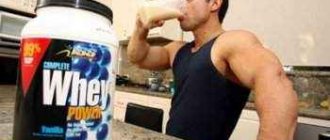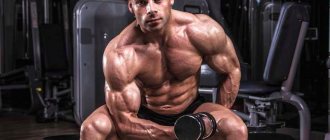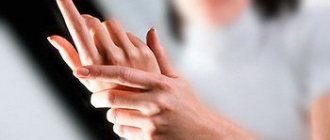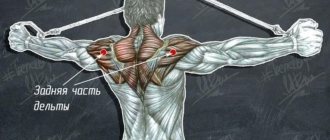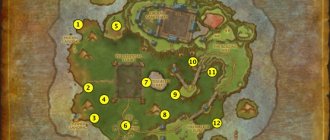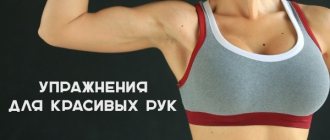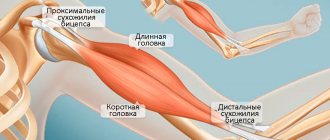Share:
The crossover crossover is an effective isolated exercise for developing the chest muscles. By performing it in different variations, you can focus the load on different parts of the pectoral muscles: upper, lower, inner or lower part. There are several basic variations of crossover hand movements: standing, lying on a bench, through upper or lower blocks. How to correctly do all variations of this exercise will be discussed in our article today.
Get ready to exercise!
Let's remember our school days - 5-minute exercises during recess.
Starting position: legs together, arms apart. One hands up, two hands in front of you. All in order to bring the shoulder girdle out of a state of stagnation. Drive away the blood, saturate it with oxygen. Relax this area. Through the relaxed muscles of the upper shoulder girdle, oxygen will flow to the head, or rather to the brain.
This was what was required from the change: so that children could continue to study and not fall asleep from fatigue, or more precisely, from a lack of oxygen supply to the brain.
This wonderful practice is forgotten as we grow older. We sit at our computers, slouched, for hours without moving. The shoulder muscles and collar area become tight from fatigue, and over time you want to straighten your back, but it’s difficult. And the less often we try to straighten it, the more we fix the stoop.
The tight muscle shortens and therefore cannot be returned to its original position. A pinched muscle compresses the nerve endings and when you try to somehow stretch this area with your hands, it causes pain. The muscle contracts, and with it the blood vessels, making it more difficult for the body to pump blood there and saturate the cells with oxygen. You get tired quickly and headaches appear.
Treatment for shoulder pain when raising your arm up
Considering the complex structure of the shoulder joint and the many diseases that can manifest as painful raising of the arm up, it is impossible to independently determine the cause of the discomfort.
When you are in such a situation, first of all, you need to consult with a therapist who, depending on the expected diagnosis, will refer you to a specialized specialist, for example, a rheumatologist. To accurately determine the pathology, he will prescribe a series of laboratory and instrumental studies (blood tests, X-rays, ultrasound, MRI and others), based on the specific situation. Only after a diagnosis has been established will the doctor prescribe adequate comprehensive treatment.
Often, treating pain in the right or left shoulder when raising the arm is similar to getting rid of pain during any action with the arm, since they are caused by the same reasons or diseases.
Treatment methods
What treatment methods are used for shoulder pain when raising the arm?
The specific treatment is prescribed by the doctor, which depends on your pathology and individual situation. In the table below I have listed the therapy methods that are often used for shoulder pain:
(if the table is not completely visible, scroll to the right)
Connecting a natural vacuum cleaner
The muscles do not move, and the body’s vacuum cleaner, its lymphatic system, does not move. Decomposition products are not removed and slagging occurs in this area. This means that the body cannot cope with viral colds and upper respiratory tract diseases.
The chest has its own lymph nodes, and they are located on both sides of the sternum. 25% of all lymph fluid from the chest organs passes through them. This is especially important for women. Stagnation in these nodes serves as a site for breast cancer metastasis.
But it is into the axillary group of lymph nodes that lymph flows from the entire upper shoulder girdle. Lymph nodes are the filters of our body. They fight the removal of foreign bodies, cells and microorganisms. And in order for movement and cleansing to constantly occur at these intersections, it is necessary to support this with muscle movement.
Stand with your back to the wall as close as possible. Bring your shoulder blades together to straighten your chest. As you exhale, raise one arm up in front of you and try to bring it as close to the wall as possible. When your hand is vertical, reach towards the ceiling as if you want to reach it. At the same time, keep your head straight. Draw in your stomach and freeze until you exhale all the air. Smoothly lower as you inhale and repeat with the other hand. After performing the exercise with each hand at least 5 times, perform it with both hands at the same time. The next time you perform this exercise, raise your arms out to the sides. This way you will strengthen the shoulder muscles, stretch the intercostal muscles and back muscles, which will help the spine stretch, the muscles to shake a little and be saturated with oxygen.
Don't do the exercises automatically. Imagine that you are reaching not for the ceiling, but for the rainbow. Enter that state of extraordinary joy and blissful feeling when you see a rainbow. Take yourself back to that serene childhood when you ran towards the rainbow with your hands raised and believed that if you reached the end of the rainbow, your deepest desire would come true.
Then these simple exercises will allow you to maintain beautiful posture and even in old age you will be able to proudly walk with your grandchildren, showing them an example of a stately figure, and rejoice with them, raising your arms high.
Raising hands before and after bowing from the waist: sunnah or makrooh?
Every Muslim tries to perform namaz according to the Most Pure Sunnah of our Prophet (s.a.w.). However, the need for certain movements during prayer causes controversy among the Ulama. An example of this is raising the hands to the shoulders before and after a bow from the waist.
The obligation to perform this action at the very beginning of the prayer - when pronouncing takbir-tahrim ("Allahu Akbar!") - is beyond doubt. As for its repetition within rak'ahs, there are disagreements, primarily due to which madhhab the believer adheres to.
Arguments for"
According to the Shafi'i and Hanbali madhhabs, such movements before and after ruku' are considered sunnat. There are many arguments in favor of this opinion.
It is reported from the words of Muhammad ibn Amr (r.a.) that the Final Messenger of God (s.g.v.), standing for prayer, made a movement with his hands, raising them to his shoulders, and pronounced the welcoming takbir. Then he straightened his body and read the Holy Quran, and then said “Allahu Akbar!” and again performed a similar action with his brushes. This was followed by a bow from the waist, then he came out of it, raising his hands again to the same position (Bukhari, Muslim). The companion of the Prophet (s.g.w.) and the son of Sahabah Umar al-Farooq, Abdullah (r.a.), also reported that the Grace of the Worlds, Muhammad (s.g.w.), performed the appropriate gestures in prayer (Bukhari).
In addition, the famous Shafi'i theologian Imam al-Nawawi, in his treatise "Majmu", cites the opinion that all the Sahaba also made similar body movements during prayer. Another authoritative scholar, Hajar al-Askalani, argued that about 50 hadiths have survived to this day, confirming the legitimacy of raising hands.
Based on all of the above, the Shafi'is and Hanbalis call this practice desirable.
Cons
Opponents of raising the hands before performing ruku and when leaving it are supporters of the madhhabs of Abu Hanifa and Imam Malik. They admit that originally the Messenger of Allah (saw) and his Sahabah did this, as stated in the hadith mentioned above. But over time, this practice was revised, it was abolished, and the first Muslims stopped raising their hands during takbirs inside prayer.
The Hanafis and Malikis cite several Dalils to support their position. Firstly, these are the first verses of Surah “The Believers”, which say:
Verily, the believers who are humble during their prayers have prospered (23:1-2)
In this case, humility also means the absence of unnecessary body movements, which, according to representatives of these madhhabs, includes the phenomenon discussed in this article (with the exception of the greeting takbir at the very beginning of the prayer).
Another of their arguments is a hadith that tells us that our Prophet (s.a.w.), seeing people raising their hands inside the rakats of prayer, asked them the question: “What happened? I saw how you raised your hands like the tails of jumping horses. Show humility in prayer!” (Muslim). Another hadith reports that the companion Abdullah ibn Masud (r.a.) asked the believers: “Shall I demonstrate to you how the leader of the faithful, Muhammad (s.a.w.) prayed?” After which he performed the prayer and did not raise his hands to his shoulders, except for the first time, i.e. takbir tahrim at the very beginning. (Tirmidhi).
Based on the above arguments, Hanafis and Malikis consider the practice of raising hands to be abolished during the lifetime of the Messenger of the Almighty (s.g.w.), which means that such movements in the process of worship are “superfluous”, and this is makruh.
And the truth is known only to Allah!
Keeping Mobility
As people age, many people gain excess weight. In women, problem areas become the back of the arm, the subscapular region up to the armpits - this limits mobility in the shoulder joint.
Weak arms and stooping deform the spine; over time, osteochondrosis of the thoracic and cervical spine develops. Signs include aching pain between the shoulder blades and numbness in the fingers. Cervical osteochondrosis is the most dangerous due to the large number of nerve and blood vessels that supply our brain. Dizziness is added to the headache.
Closer to 70 years of age, the upper shoulder girdle becomes so cemented that older people, instead of turning their heads to the right or left, or moving their arms back, are forced to turn their whole body.
In order to maintain mobility of the shoulder joint, a wide towel is enough.
We washed our face in the morning and dried ourselves with a towel. Now take it by the edges and pull it back behind your back with straight arms. Perform 20 forward and backward movements with your arms. Gradually try to reduce your grip on the towel.
This way you will maintain the mobility of the joint, stretch the muscle group surrounding this joint and strengthen the shoulder muscles.
The structure of the muscles of the human arm
Human hands have a huge number of muscles. With their help, a person can move his hands and perform actions transmitted by brain impulses.
The muscles of the arms are usually classified into the muscles of the shoulder girdle and the free upper limb.
The first ones are divided into:
- deltoid (superficial muscle of the shoulder, having a triangular shape),
- supra- and infraspinatus (located under the deltoid),
- small and large round (located in the center of the shoulder blade),
- subscapular.
How to treat glenohumeral periarthrosis?
The latter can be divided into:
- shoulder group,
- forearm group.
The shoulder group is usually divided into anterior and posterior. The anterior one, in turn, has the humerus, biceps, coracobrachialis, and the back has the triceps and ulna.
The muscles of the forearm include the brachialis (brachialis) and brachioradialis (brachyradialis).
The muscles of the hand are predominantly located on the palmar surface (palm muscles). The anatomy of the muscles of the human hand includes the lateral, medial and middle groups. The first is responsible for the movements of the thumb, the second for the movements of the little finger, and the third for all the remaining fingers of the hand.
Many people have a question: “Are there muscles in the fingers?” The answer to this question is no. A person moves his fingers only with the help of tendons controlled by the muscles of the forearm.
Removing the blocker using self-massage
The body's resources are not limitless. Any chronic disease manifests itself after many years, sometimes it takes 10-15 years or more.
If you do not pay attention to the upper shoulder girdle, then at a certain stage the load will transfer to the next section of the spine. Therefore, only proportional load and harmonious development of all muscle groups will provide you with a healthy and active body.
Lymph moves only due to the contraction of the muscles that surround it. In order to stimulate the movement of lymph throughout the body, I suggest one more exercise.
First, we find a point located in the solar plexus. This point in Tibetan medicine is called the Adkan point. It is responsible for skin hydration, joint strength, muscle elasticity and mental patience, and most importantly, for drainage in our body. It collects lymph from the entire body, from the limbs and from the head.
If you feel pain when you press on it, then the pain point is a blocker of the movement of lymphatic fluid, its stagnation to remove decay products. From this point two ducts emerge, which go to the collarbones, and there the lymph drains into the veins.
Start working on the point using acupressure. Press on it as much as you can bear. Stroke periodically. Move your finger clockwise and counterclockwise. Rub and iron again.
Then, from the Adkan point, towards the collarbones, carry out massaging movements, trying to reach the muscles, and not just touch the skin.
Perform the movements with love and care to free up the lymphatic system and provide an outlet for accumulated waste in the body.
Active influence on the problem area
Massage or self-massage is a passive load on the muscles.
In order to activate the muscles and increase the degree of slagging release, we perform a simple exercise.
Standing, feet shoulder-width apart, feet parallel. Raise your arms to the sides to shoulder level and bend your elbows with your palms facing up. We maintain right angles between the joints. While inhaling, through the nose, we move our elbows back as far as possible, but do not lower them, connect the shoulder blades and hold for several seconds. At the same time, we lower our head back, stretching the neck muscles.
As you exhale (also through the nose), we connect our elbows in front of us at chest level, lower our head down, touch our chin to the décolleté area, and stretch the neck muscles from the back.
We do it 7 times.
Shake your shoulders, do a few back and forth circles, and move on with your day.
Safety
In any exercise performed in a crossover, it is important to follow the correct technique. This is the only way to protect yourself from possible injuries. You should immediately eliminate any jerking movements, as they pose the greatest danger to the joints. If the weight set on the simulator seems completely unbearable, then it can be reduced.
Like any other isolation exercise, crossover curls should be performed at the end of the workout . The fact is that this type of exercise involves increased load on one working muscle, so it must be ready to receive it. Otherwise, the training will be useless.

